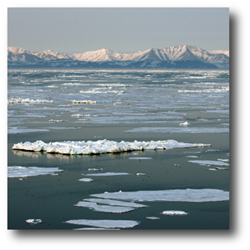 Impacts of Sea Ice Variability and Polynya Formation on Biological Productivity in the Northern Bering Sea
Impacts of Sea Ice Variability and Polynya Formation on Biological Productivity in the Northern Bering Sea
Funding Agency: NSF Office of Polar Programs, Arctic Natural Sciences Program
Funding Period: 2007-2010
The Bering Sea is among the most productive marine ecosystems in the world, supporting important commercial fisheries, subsistence resources for Native Alaskans, and large populations of marine birds and mammals. However, some higher trophic organisms have recently been categorized as threatened or endangered, suggesting ecosystem change may be in progress. Although sea ice is currently a dominant feature in this high-latitude shelf environment, we have no clear understanding of how climate warming and associated variability in sea ice cover will influence ecosystem structure and function in this region. It is likely, however, that further significant ecosystem shifts will transpire with projected declines in seasonal sea ice cover. This research utilizes satellite remotely sensed data to investigate key temporal and spatial linkages between sea ice variability, polynyas, and chlorophyll biomass throughout the northern Bering Sea region, which can be subsequently used to predict how warming and an associated reduction in sea ice cover will affect productivity at all levels. Several field seasons onboard the USCGC Healy icebreaker were carried out in support of this project.
Resulting Publications:
Frey, K. E., J. A. Maslanik, J. Clement Kinney & W. Maslowski (2014), Recent variability in sea ice cover, age, and thickness in the Pacific Arctic Region. In: Grebmeier, J. M. & W. Maslowski (eds.) The Pacific Arctic Region: ecosystem status and trends in a rapidly changing environment. Springer: Dordrecht, pp. 31–64. pdf copy
Cooper, L. W., M. Janout, K. E. Frey, R. Pirtle-Levy, M. Guarinello, J. M. Grebmeier & J. R. Lovvorn (2012), The relationship between sea ice break-up, water mass variation, chlorophyll biomass, and sedimentation in the northern Bering Sea. Deep Sea Research II 65–70, 141–162. pdf copy
Fu, H., J. Zhao & K. E. Frey (2012), Investigation of polynya dynamics in the northern Bering Sea using greyscale morphology image-processing techniques. International Journal of Remote Sensing 33, 2214–2232, doi:10.1080/01431161.2011.608088. pdf copy
Grebmeier, J. M., J. C. Priscu, R. D’Arrigo, H. W. Ducklow, C. Fleener, K. E. Frey & C. Rosa (2011), National Research Council of the National Academies Report: Frontiers in Understanding Climate Change and Polar Ecosystems. The National Academies Press: Washington D.C., 84 pp. website
Grebmeier, J. M., S. E. Moore, J. E. Overland, K. E. Frey & R. R. Gradinger (2010), Biological response to recent Pacific Arctic sea ice retreats. Eos, Transactions, American Geophysical Union 91, 161–162. pdf copy
